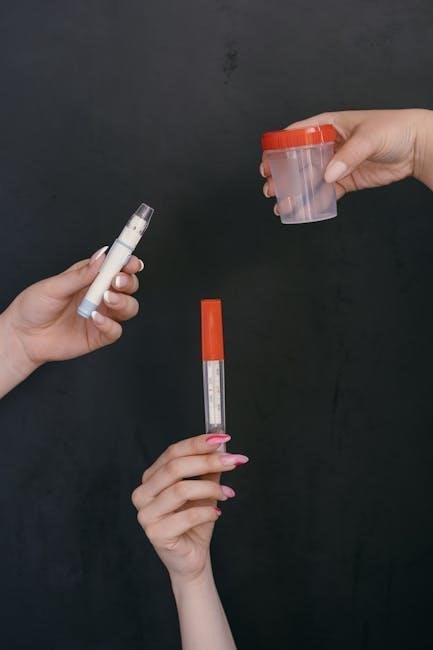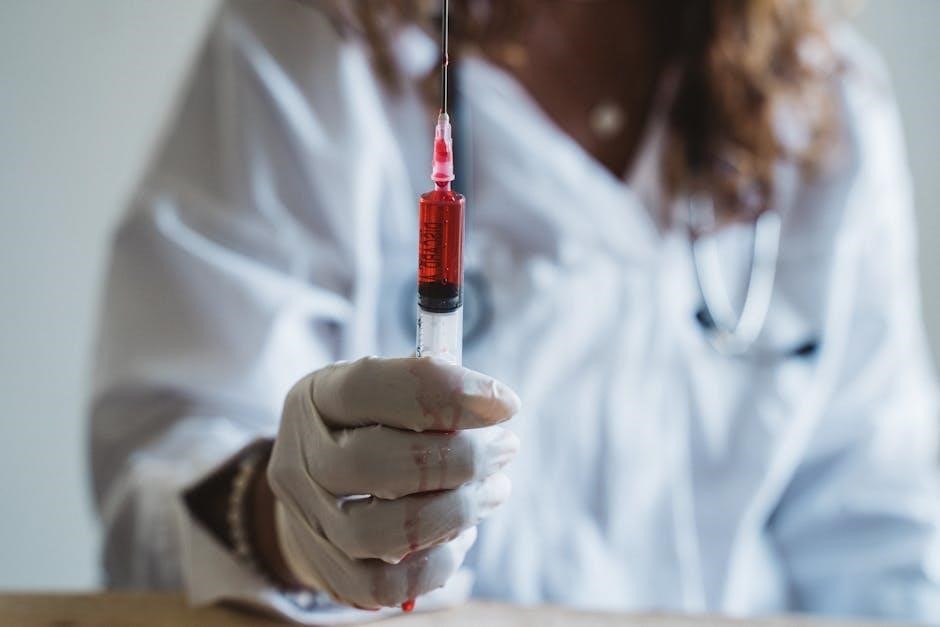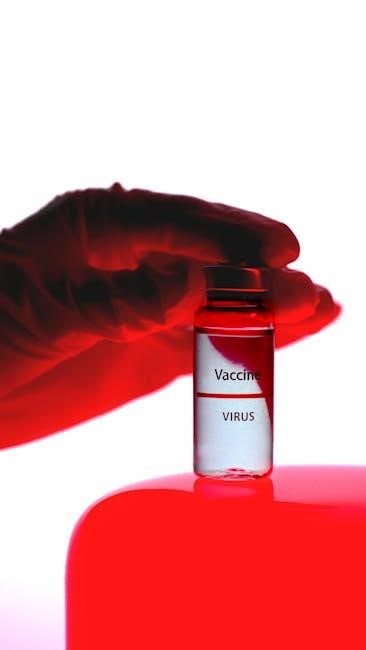First aid is the immediate care given to someone injured or suddenly ill. It provides crucial assistance, preventing conditions from worsening until professional help arrives.
1.1. What is First Aid?
First aid is the immediate care given to an injured or ill person to preserve life, prevent worsening, and promote recovery. It involves simple, non-invasive procedures like wound cleaning, applying bandages, and CPR. First aid is not a substitute for professional medical care but serves as a critical initial response to emergencies, ensuring safety until help arrives.
1.2. Why First Aid Knowledge is Crucial
First aid knowledge is crucial as it enables individuals to respond effectively during emergencies, saving lives and reducing injury severity. It builds confidence, ensuring timely interventions that prevent conditions from deteriorating. Knowing first aid empowers bystanders to act decisively, making a significant difference in outcomes before professional medical help arrives. It is a vital skill for everyone.
1.3. Benefits of Learning First Aid
Learning first aid equips individuals with the skills to save lives, reduce recovery time, and prevent minor injuries from becoming severe. It fosters confidence in emergency situations, empowering bystanders to act swiftly. First aid training also promotes a safer community, enabling individuals to respond effectively until professional help arrives. The benefits extend beyond emergencies, enhancing overall preparedness and responsibility.

The Primary Survey in First Aid
The primary survey is the first step in assessing a casualty. It involves checking for danger, response, airway, breathing, and circulation (DRABC) to identify immediate needs.
2.1. What is the Primary Survey?
The primary survey is the initial assessment of a casualty to identify life-threatening conditions. It follows the DRABC approach: Danger, Response, Airway, Breathing, and Circulation. This systematic method ensures first responders address critical issues first, such as an obstructed airway or lack of breathing, to stabilize the casualty before further care.
2.2. The DRABC Approach
The DRABC approach is a systematic method used in first aid to assess and prioritize care. It stands for Danger, Response, Airway, Breathing, and Circulation. First, ensure the scene is safe (Danger). Check the casualty’s responsiveness (Response). Clear the airway, ensure normal breathing, and control bleeding or shock (Circulation). This sequence helps first responders address life-threatening issues efficiently.
2.3. How to Apply the Primary Survey in Real-Life Scenarios
In real-life emergencies, the primary survey ensures systematic assessment. Start by checking the environment for hazards. Assess the casualty’s responsiveness and airway patency; Look for breathing difficulties or absence. Control severe bleeding and check for signs of circulation issues like pale skin or rapid heartbeat. This methodical approach ensures critical conditions are identified and addressed promptly.

Common First Aid Test Questions and Answers
This section covers frequently asked questions about first aid, including multiple-choice, true/false, and scenario-based queries, designed to test knowledge and application in emergency situations effectively.

3.1. Multiple-Choice Questions on Basic First Aid
These questions assess foundational knowledge, such as identifying the primary survey steps or appropriate wound care. Examples include: “What is the first step in first aid?” or “How should a minor burn be treated?” Answers are provided to reinforce learning and understanding of essential first aid principles.
3.2. True or False Questions on First Aid Procedures
These questions test knowledge of correct first aid actions. Examples include: “You should apply ice to a burn immediately.” or “All fractures require immobilization.” Answering these helps confirm understanding of proper procedures, ensuring accurate and safe responses in emergencies. They cover essential topics like wound care, burns, and cardiac arrest.
These questions present real-life situations, like choking or burns, requiring test-takers to outline appropriate first aid steps. They assess practical application, ensuring learners can respond effectively in emergencies. Examples include handling anaphylaxis or fractures, reinforcing critical thinking and decision-making skills essential for saving lives. They bridge theory with actionable knowledge, enhancing preparedness. Basic first aid procedures include stopping bleeding, cleaning wounds, applying dressings, and using antibiotic ointment. These steps ensure proper immediate care for injuries like cuts, burns, or fractures. For cuts and lacerations, immediately stop bleeding by applying direct pressure with a clean cloth or bandage. Clean the wound with cool or lukewarm water to remove dirt. Apply antibiotic ointment to prevent infection, then cover with a sterile dressing. Monitor for signs of infection, such as redness or swelling. Seek medical attention if the wound is deep or won’t stop bleeding. For minor burns, cool the area with cool tap water for 10-15 minutes. Remove any clothing or jewelry near the burn. Cover with a non-stick sterile dressing. Do not apply ice or ointments. For severe burns, cool the area, cover with a clean cloth, and seek immediate medical attention. Prevent infection and promote healing by keeping the burn clean and protected. If someone is choking, perform back slaps or abdominal thrusts to dislodge the object. For drowning, remove excess water and check breathing. If unresponsive, start CPR. Keep the person calm and seek medical help immediately. Ensure the airway is clear and provide oxygen if trained. Always prioritize immediate intervention to prevent further complications. Emergency scenarios demand quick thinking and effective first aid. From choking to cardiac arrest, immediate care can prevent severe outcomes, ensuring safety until professional help arrives. Anaphylaxis is a severe, life-threatening allergic reaction requiring immediate intervention. Administer an epinephrine auto-injector, call emergency services, and keep the person calm. Do not give oral medications. Lay the person flat, elevate their legs, and monitor breathing until help arrives. Recognizing symptoms like swelling, difficulty breathing, and rapid heartbeat is crucial for timely action. During a cardiac arrest, ensure the scene is safe, call emergency services, and start CPR with chest compressions. For a heart attack, assist the person to rest, administer aspirin if available, and monitor symptoms until medical help arrives. Early intervention significantly improves survival rates and outcomes for both conditions. For fractures and sprains, provide immediate care by immobilizing the affected area and applying the RICE method: Rest, Ice, Compression, and Elevation. Look for signs like pain, swelling, or inability to move the limb. Avoid moving the person unnecessarily and seek professional medical help for proper diagnosis and treatment, such as casting or bracing, to prevent further injury. First aid training equips individuals with essential skills to respond confidently in emergencies, enhancing their ability to provide immediate care and potentially save lives. First aid training is vital as it empowers individuals to act swiftly in emergencies, reducing risks and improving outcomes. It builds confidence, enhances safety, and fosters a proactive community response to medical crises, ensuring timely interventions that can prevent minor injuries from becoming severe; Regular training updates skills, keeping responders informed on best practices. To excel in a first aid exam, thoroughly review training materials and practice with sample questions. Focus on understanding key concepts like the primary survey, wound care, and CPR. Utilize online resources and study guides to reinforce learning. Regular practice helps build confidence and ensures readiness to apply knowledge effectively in real-life scenarios. Stay calm during the exam to perform optimally. First aid providers play a crucial role in emergencies by delivering immediate care and stabilizing conditions until professional help arrives. Their responsibilities include assessing the situation, providing appropriate interventions, and maintaining communication with the casualty. By acting swiftly and confidently, they help prevent further harm and improve outcomes, making them indispensable in life-threatening scenarios. Reliable websites, first aid training manuals, and online resources provide comprehensive test questions and answers. These sources help individuals prepare effectively for exams and practical scenarios. Websites like Red Cross, St John Ambulance, and Health & Safety Training Ltd offer reliable first aid practice questions. These platforms provide multiple-choice questions, true/false tests, and scenario-based exercises to enhance understanding. They also include downloadable PDF guides and answer keys for self-assessment, ensuring comprehensive preparation for first aid exams and practical applications. Reputable organizations like Red Cross and St John Ambulance provide comprehensive first aid manuals. These guides include detailed explanations of primary surveys, wound care, and emergency response techniques. Many are available in PDF format, offering step-by-step instructions and diagrams for easy learning. They serve as invaluable resources for both training and quick reference in real-life scenarios. Utilize search engines with specific terms like “first aid test questions PDF” to find reliable materials. Visit trusted websites such as Red Cross or St John Ambulance for accurate information. Employ filters to narrow results by date and type, ensuring up-to-date content. First aid knowledge is vital for saving lives and preventing worsening injuries. Regular training and practice ensure preparedness in emergencies, making it a skill everyone should master. First aid is essential for providing immediate care in emergencies. Key points include the primary survey using DRABC, managing injuries like cuts and burns, and understanding life-threatening conditions such as cardiac arrest. Regular training and practice enhance skills, ensuring effective responses. Always follow proper procedures to prevent further harm and improve outcomes until professional help arrives. Continuous learning in first aid is vital for staying updated on best practices. Regular training and practice enhance confidence and competence in emergencies. Exploring resources, attending workshops, and taking refresher courses can deepen your understanding. Stay proactive in improving your skills to provide effective care and make a meaningful difference in critical situations. Keep learning to save lives. First aid knowledge is a valuable skill that can make a significant difference in emergencies. It empowers individuals to act confidently, potentially saving lives. Regular training and practice ensure preparedness for various scenarios. Encourage others to learn and stay updated, fostering a community ready to respond effectively in critical situations. First aid is not just a skill—it’s a lifeline.3.3. Scenario-Based Questions for Practical Understanding


Basic First Aid Procedures
4.1. First Aid for Cuts and Lacerations
4.2. First Aid for Burns and Scalds
4.3. First Aid for Choking and Drowning

Emergency Scenarios and First Aid Response
5.1. First Aid for Anaphylaxis and Allergic Reactions
5.2. First Aid for Cardiac Arrest and Heart Attacks
5.3. First Aid for Fractures and Sprains

The Importance of First Aid Training
6.1. Why First Aid Training is Essential
6.2. How to Prepare for a First Aid Exam
6.3. The Role of First Aid Providers in Emergencies

Sources for First Aid Test Questions and Answers
7.1. Reliable Websites for First Aid Practice Questions
7.2. First Aid Training Manuals and Guides
7.3. How to Use Online Resources Effectively

8.1. Summary of Key Points
8.2. Encouragement to Pursue Further Learning
8.3. Final Thoughts on the Importance of First Aid Knowledge
